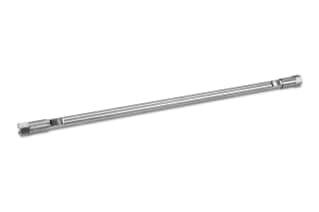
|
Chemistry |
PFP/Fluoro-Phenyl |
|
Separation Mode |
Reversed Phase |
|
Particle Substrate |
Silica |
|
pH Range Min |
2 pH |
|
pH Range Max |
8 pH |
|
Maximum Pressure |
6000 psi (415 Bar) |
|
Endcapped |
No |
|
Bonding Technology |
PFP |
|
Silanol Activity |
High |
|
Particle Shape |
Spherical |
|
Particle Size |
5 µm |
|
Endfitting Type |
Waters |
|
Pore Size |
100 Å |
|
Format |
Column |
|
Surface Area |
230 |
|
System |
HPLC |
|
Particle Technology |
HSS |
|
USP Classification |
L43 |
|
Inner Diameter |
4.6 mm |
|
Length |
250 mm |
|
Carbon Load |
7 % |
|
UNSPSC |
41115709 |
|
Brand |
XSelect |
|
Product Type |
Columns |
|
Units per Package |
1 pk |

XSelect HSS PFP Column, 100Å, 5 µm, 4.6 mm X 250 mm, 1/pk
The non-end-capped Waters XSelect HSS PFP (pentafluorophenyl) Column is a piece of silica-based HPLC lab equipment that has been created for low pH separations that require alternate selectivity to a completely end-capped, high coverage C18 phase. The XSelect HSS PFP HPLC columns can be used with ACQUITY UPLC separations and are fully scalable. It provides a special phase for bases and planar aromatic molecules.
One of the most reliable, repeatable, and scalable silica-based PFP LC columns on the market is the XSelect HSS PFP Column. The real PFP performance is provided by the special combination of HSS substrate and PFP ligand without sacrificing peak shape and retention time variation.
When you require higher compound retention, especially for basic polar analytes, whose retention is challenging with C18 stationary phases, rely on the XSelect HSS PFP Column. PFP phases are electron acceptors; hence these ligands will interact pi-pi with Lewis base-containing molecules. Based on the structure, dipole moment, and interactions with hydrogen bonds of the analyte, the stiff aromatic ring offers extra selectivity.
For effective method development, the XSelect HSS PFP Column is offered in a variety of particle sizes and column shapes. Browse through our online store, which describes the products and their advantages, contains guides about our technology, and also enables you to buy lab equipment directly from us so you can select the best one for your investigation.
High Strength Silica (HSS) technology is used in the XSelect HSS PFP Column. This technique was developed with chromatography in mind and has various selectivity and increased polar molecule retention properties. The HSS particle possesses the mechanical strength necessary to endure UPLC pressures in addition to its analytical capability.
You may want to use the XSelect HSS PFP VanGuard Cartridge, 100Å, 5 µm, 3.9 mm X 5 mm, 3/pk in conjunction with the XSelect column in order to ensure that no unwanted contaminants enter the mobile phase and interfere with the analysis. The cartridge is made using the exact same materials as those present in the column, making the two lab equipment ideally suited to one another.
Across What pH Range Does The XSelect HSS PFP Column Operate?
The Waters XSelect HSS PFP Column listed here is able to work well across the 2-8 pH range.
Is There A Maximum Pressure That Limits The XSelect HSS PFP Column?
This particular XSelect HSS PFP Column is able to tolerate a maximum of 6,000 psi (415 Bar) pressure.